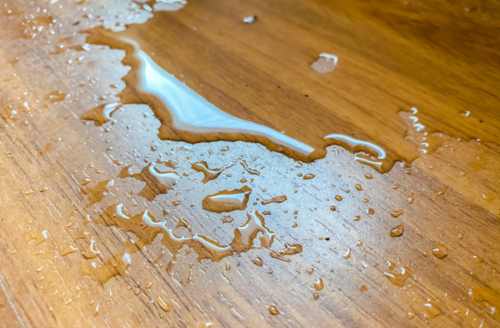Moisture causes more damage to wood flooring than almost any other factor, and it can quickly destroy the beauty and comfort you’ve come to count on from hardwood or engineered wood floors. Understanding how moisture damage occurs and learning how to treat your wood flooring properly helps to reduce the risk of damage.
Stages of Moisture Damage
Homeowners learn to take good care of their wood flooring, wiping up spills, avoiding the use of certain cleaners, brooms, and mops and generally keeping liquids off the surface of their floors. But did you know that the stages of moisture damage stretch far beyond these instances?
Common problems associated with moisture damage include:
- Cupping – when the edges of the flooring planks rise and the middle remains low, commonly caused by seasonal humidity changes, improperly dried product, or a wet subfloor
- Cracks or Gapping – when large or uneven gaps appear between the planks, commonly caused by changes in the relative humidity of the room
- Crowning or Buckling – when the middle of the plank rises and the edges remain lower, caused mainly by flooding or major surface spills.
Early stages of moisture damage may be limited to certain areas of the room or just certain planks. Damage spreads and worsens as the problem progresses or remains unaddressed. Extreme crowning is known as buckling, and gapping can move into cupping if the relative humidity problem continues.
Understanding How to Prevent Early Stages of Moisture Damage
Wood flooring products must be properly conditioned before installation to create strong, durable floors. Consider the following conditions and talk to your wood flooring installer about the steps of preparation:
- Planks need to be properly dried before installation – some products are delivered pre-dried, while others are conditioned at home.
- Subflooring must be dry before installation – this is especially important for concrete floors, which should be sealed and prepped with a stable subfloor structure and underlayment.
- Any water leaks should be repaired and any spills, puddles, and standing water dried – repair cracks and install water treatment methods before installing wood floors.
- Ambient conditions in the room need to be addressed and any relative humidity issues corrected – the US Department of Agriculture recommends relative humidity levels between 30 to 50 percent with room temperatures set between 60 to 80 degrees F.
Seasonal changes often create similar conditions to moisture damage, but the wood flooring will readjust and eventually return to normal conditions. Homeowners and contractors need to work together before installation to choose the ideal type of flooring, subfloor, and underlayment for the conditions. Always follow the established industry guidelines and read through the manufacturer’s instructions before investing in your wood flooring. Moisture damage can be costly for both homeowners and installers, as well as for retailers and flooring manufacturers. With education, understanding, and the proper steps of preparation you can avoid moisture damage to wood flooring and enjoy decades of beauty!
